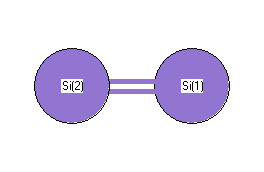Please address comments about this page to cccbdb@nist.gov.
| squib |
reference |
DOI |
| 1979HUB/HER |
Huber, K.P.; Herzberg, G., Molecular Spectra and Molecular Structure. IV. Constants of Diatomic Molecules, Van Nostrand Reinhold Co., 1979 |
10.1007/978-1-4757-0961-2 |
| 1991Kit/Chi:1441 |
TN Kitsopoulos, CJ Chick, Y Zhao, DM Neumark "Study of low-lying electronic states of Si2 and Si2- using negative ion photodetachment techniques" J. Chem. Phys. 95(3), 1441, 1991 |
10.1063/1.461057 |
| 2007Iri:389 |
KK Irikura "Experimental Vibrational Zero-Point Energies: Diatomic Molecules" J. Phys. Chem. Ref. Data 36(2), 389, 2007 |
10.1063/1.2436891 |
| Gurvich |
Gurvich, L.V.; Veyts, I. V.; Alcock, C. B., Thermodynamic Properties of Individual Substances, Fouth Edition, Hemisphere Pub. Co., New York, 1989 |
|
| NSRDS-NBS10 |
R. D. Nelson Jr., D. R. Lide, A. A. Maryott "Selected Values of electric dipole moments for molecules in the gas phase" NSRDS-NBS10, 1967 |
10.6028/NBS.NSRDS.10 |
| VEEL5 |
M.E. Jacox, Vibrational and Electronic Energy Levels of Polyatomic Transient Molecules, J. Phys. Chem.Ref. Data, Monograph 3 (1994) (updated data in NIST Chemistry Webbook - http://webbook.nist.gov/chemistry/ |
|
| webbook |
NIST Chemistry Webbook (http://webbook.nist.gov/chemistry) |
10.18434/T4D303 |










